Theory
The theory advances will focus on the foundation of applying QCD factorization theorems, including higher-order perturbative corrections and all-order resummations, to DVCS and other relevant hard exclusive processes with the goal of extracting GPDs. The theory pillar will also provide the necessary ingredients to extract the GPDs from a global analysis. In addition, we will explore non-perturbative methods to provide important insight to describe the GPDs, which can lead to a physics motivated parameterization for the global analysis.
In particular, our research will focus on the following subjects:
(1) Theory Advances in Deeply Virtual Compton Scattering
(2) Gluon Tomography with Exclusive Heavy Quarkonium Production
(3) New Processes and Observables for Probing GPDs
(4) Non-perturbative Methods for GPDs and Hadron Tomography
(5) Beyond GPDs: Wigner Distributions
Milestones
The milestones from the theory working group are in three main categories: 1) application of perturbative QCD to hard exclusive processes; 2) non-perturbative methods, including and the Covariant Parton Model; and 3) processes at small-x.
Year 1: Analyze factorization for exclusive quarkonia production at leading power for all regions using SCET and NRQCD, including the large and small $Q^2$ regions and quarkonia production at threshold
Apply the light-front Hamiltonian method to compute the GPDs, explore the nucleon spin/mass sum rule, and help to unveil the parton correlation due to strong interaction non-perturbative physics
Year 2: Make quantitative connection of the GPD factorization formalism to the CGC/color-dipole formalism for various exclusive processes
Apply the Covariant Parton Model to the GPDs of quark and gluons, eventually the parton Wigner distributions
Year 3: Use SCET to investigate factorization at subleading power in DVCS, including hadron mass corrections and the factorization and resummation of potential endpoint singularities
Year 4: Perform large-$N_c$ analysis of hard exclusive pion production with $N \rightarrow \Delta$ transitions and a combined chiral $\times 1/N_c$ analysis of nucleon energy-momentum tensor form factors
Quantitative study of hard diffractive dijet and di-hadron production at future EIC and explore novel processes to probe the quark/gluon Wigner distribution in the valence and moderate $x$ region
Year 5: Study relativistic corrections and other subleading effects in heavy quarkonia production for cases where such corrections are likely to be important
Recent Highlights
(see also, https://sites.google.com/lbl.gov/qgttheory/progress?authuser=0):
Bayesian Inferring Nucleon’s Gravitational Form Factors
Yuxun Guo, Feng Yuan and Wenbin Zhao, Bayesian Inferring Nucleon’s Gravitation Form Factors via Near-threshold J/ψ Photoproduction, Phys. Rev. Lett. 135, 111902 (2025), – Published 10 September, 2025.
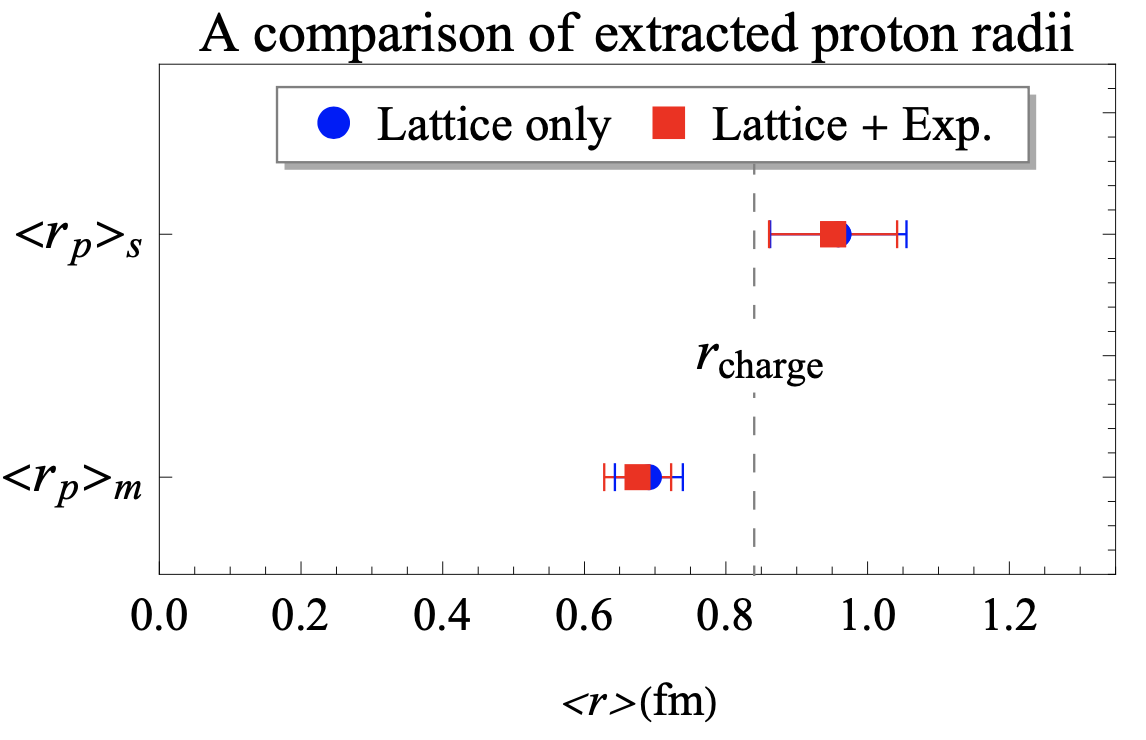
With Bayesian inference, we investigate the impact of recent near-threshold J/ψ production measurements by the J/ψ 007 experiment and GlueX collaboration on the extraction of proton’s gravitational form factors. We apply the generalized parton distribution framework at the next-to-leading order and demonstrate a stable expansion for the near-threshold kinematics. We find that the experimental constraints are in good agreement with the state-of-the-art lattice simulations, where negative Cq(t) and Cg(t) are strongly preferred. This highlights a great potential to extract them from future high-precision experiments.
The figure shows the average proton mass and scalar radii with parameters sampled from their posterior distributions as compared to the lattice result.
String Theory Inspiration for the GPD Models
Kiminad A. Mamo and Ismail Zahed, Parametrization of Generalized Parton Distributions from t-Channel String Exchange in AdS Spaces, Phys.Rev.Lett. 133 (2024) 24, 241901, Published 10 December, 2024
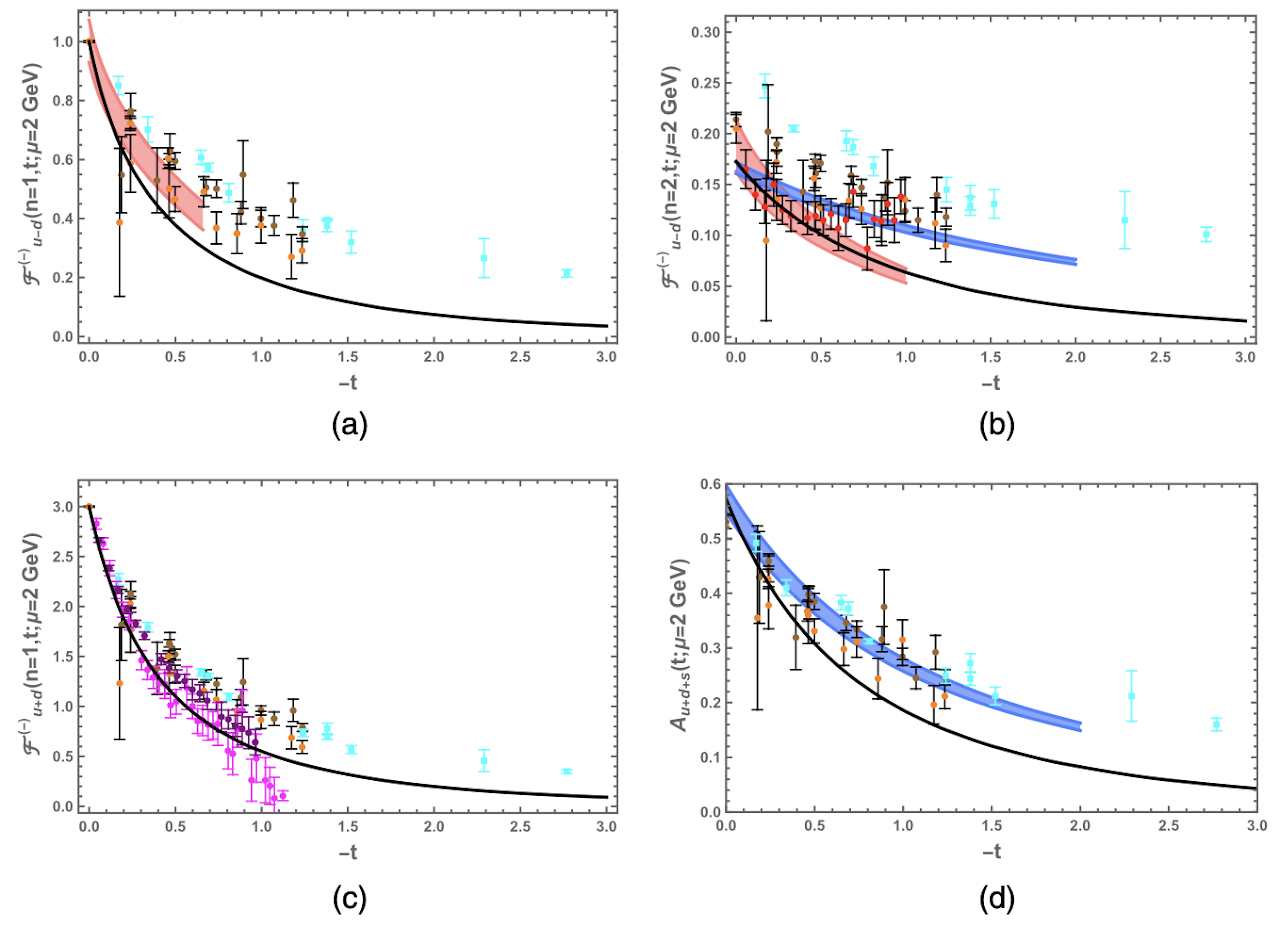
A string-based parametrization for nucleon quark and gluon generalized parton distributions (GPDs) is introduced. This approach leverages conformal moments, representing them as the sum of spin-j nucleon A-form factor and skewness-dependent spin-j nucleon D-form factor, derived from t-channel string exchange in AdS spaces consistent with Lorentz invariance and unitarity. This model-independent framework, satisfying the polynomiality condition due to Lorentz invariance, uses Mellin moments from empirical data to estimate these form factors. With just five Regge slope parameters, our method accurately produces various nucleon quark GPD types and symmetric nucleon gluon GPDs through pertinent Mellin-Barnes integrals. Our isovector nucleon quark GPD is in agreement with existing lattice data, promising to improve the empirical extraction and global analysis of nucleon GPDs in exclusive processes, by avoiding the deconvolution problem at any skewness, for the first time.
The figure here shows the evolved conformal moments j=n=1, 2 of the quark u−d (a),(b), the quark u+d (c),(d) GPDs at the resolution μ=2GeV. Our results are illustrated with black curves compared to various lattice data.
Colloquium: Gravitational Form Factors of the Proton
V. D. Burkert, L. Elouadrhiri, F. X. Girod, C. Lorce, P. Schweitzer, and P. E. Shanahan, [Rev.Mod.Phys. 95 (2023) 4, 041002] (https://journals.aps.org/rmp/abstract/10.1103/RevModPhys.95.041002)
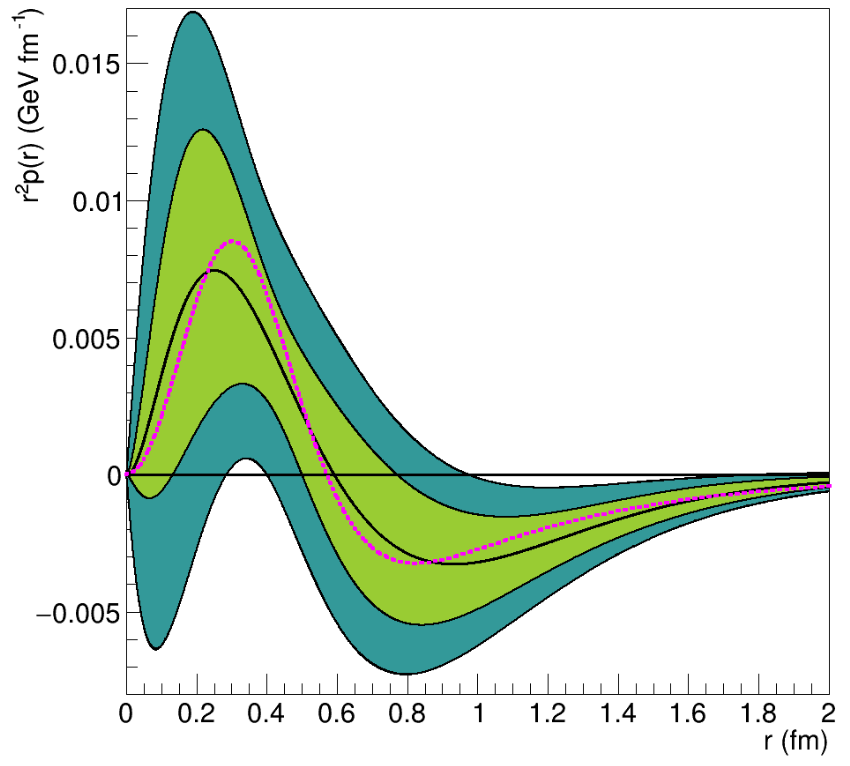
The matrix elements of the energy-momentum tensor are the key to understanding how the properties and structure of particles like the proton arise from their quark and gluon constituents. These matrix elements are described in terms of gravitational form factors, which encode such fundamental information as the proton’s mass, spin and the less well-known but equally fundamental D-term. Moreover, the form factor associated with the D-term is related to the stress tensor and internal forces in the proton, providing access to its `mechanical properties’, which has emerged as a vibrant research field in its own right. This article presents the immense progress in the physics of gravitational form factors including the mass and spin decompositions of the nucleon and its mechanical properties. The authors review at an accessible colloquium-style level the advances in theory, experiments, first-principle lattice QCD studies, model calculations and the interpretation of these fundamental quantities.
Nucleon-Energy-Energy-Correlators to Probe Quantum Entanglement at the LHC
Yuxun Guo , Xiaohui Liu , Feng Yuan, and Hua Xing Zhu, Long-Range Azimuthal Correlation, Entanglement, and Bell Inequality Violation by Spinning Gluons at the Large Hadron Collider, Science Partner Journal, Research, Vol 2025, Article ID: 0552, Published 5 Feb 2025

The newly developed concept of the nucleon energy–energy correlator (NEEC) for the gluon sector is applied to investigate the long-range azimuthal angular correlations in proton–proton collisions at the Large Hadron Collider. The spinning gluon in these collisions will introduce substantial nonzero cos(2ϕ) asymmetries in both Higgs boson and top quark pair productions, where ϕ is the azimuthal angle between the forward and backward energy correlators in the NEEC observables. The genesis of the cos(2ϕ) correlation lies in the intricate quantum entanglement. Owing to the substantial cos(2ϕ) effect, the NEEC observable in Higgs boson and ttbar production emerges as a pivotal avenue for delving into quantum entanglement and scrutinizing the Bell inequality at high-energy colliders.
The figure here illustrates the nucleon energy–energy correlator measurements in proton–proton collisions at the Large Hadron Collider. Energy deposits in the forward directions of both incoming hadron beams with polar angles θa,b and azimuthal angles ϕa,b.
Quark Counting Rule Revisted for Pion Structure Function and Form Factor
Mary Alberg and Gerald A. Miller, Quark counting, Drell-Yan West, and the pion wave function, Phys.Rev.C 110 (2024) 4, L042201 Published: Oct 4, 2024
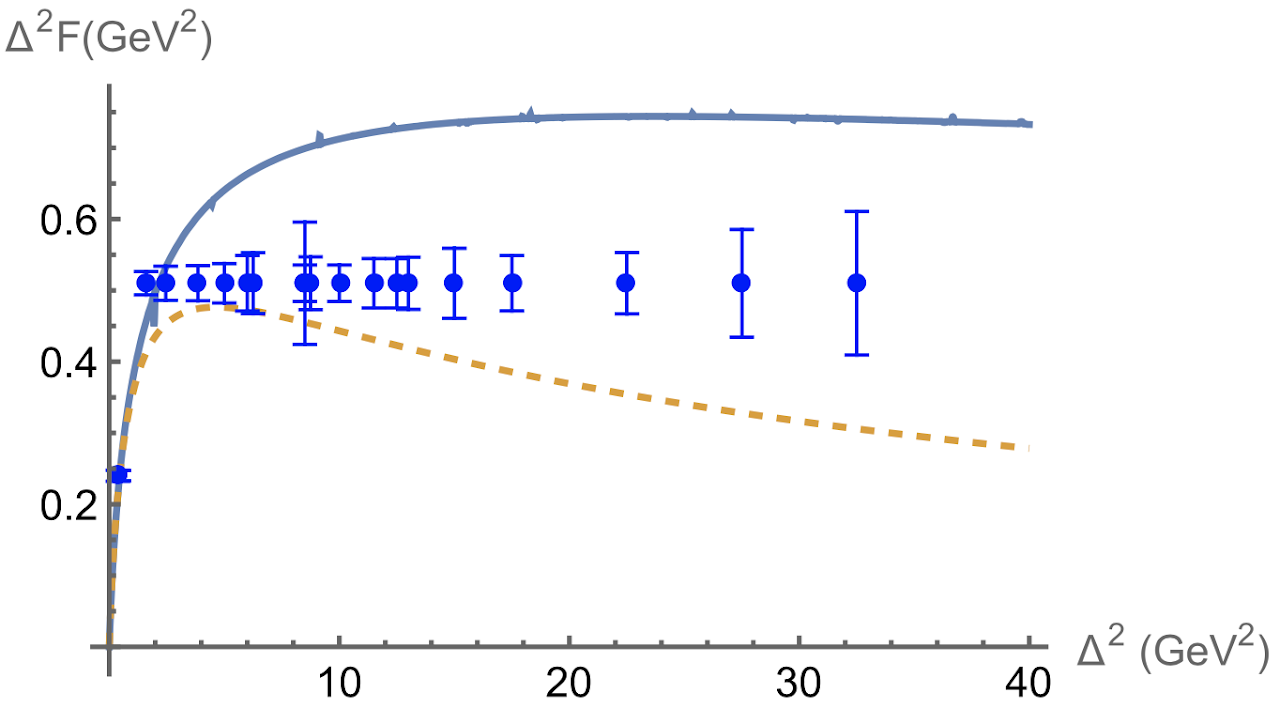
The relation between the pion’s quark distribution function, q(x), its light-front wave function, and the elastic charge form factor, F(𝑄2), is explored. The square of the leading-twist pion wave function at a special probe scale, ζH, is determined using models and Poincaré covariance from realistic results for q(x). This wave function is then used to compute form factors with the result that the Drell-Yan-West and quark counting relationships are not satisfied. A new relationship between q(x) and F(𝑄2) is proposed.
The figure here shows that future experiments at JLab will be able to distinguish these two models.
Transversity GPDs: Revealing the nucleon’s “other” chiral spin structure
J-Y Kim, Christian Weiss, Chiral-odd generalized parton distributions in the large-Nc limit of QCD: Spin-flavor structure, polynomiality, and sum rules, Phys. Rev. D 111, 074007 (2025)
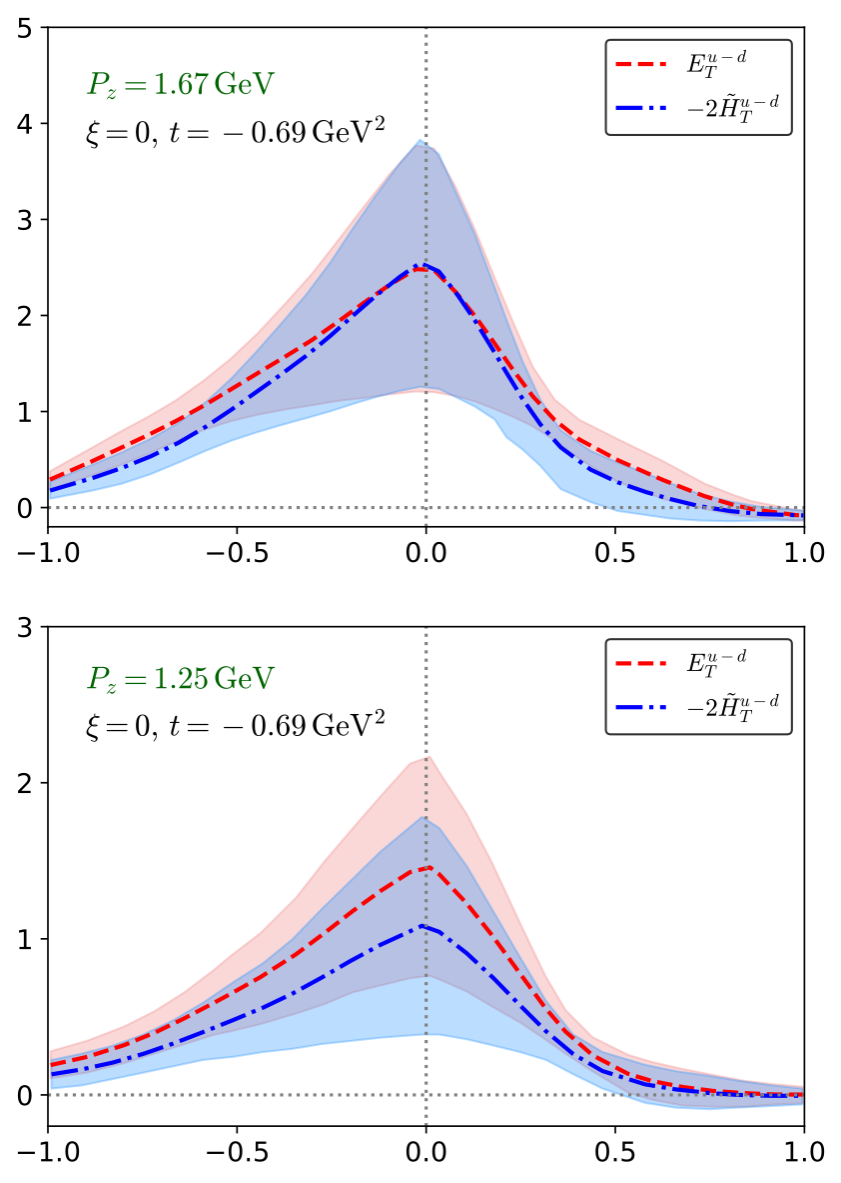
Transversity generalized parton distributions (chiral-odd GPDs) describe the 3D distributions of transversely polarized quarks in the nucleon. The quark spin is entangled with the nucleon spin and orbital motion (momentum transfer), producing a rich structure Results. In this study, we performed structural analysis revealing complex “multipole” structure of transversity GPDs and predicted dynamical relations between spin-flavor components in large-Nc limit of QCD, confirmed by lattice QCD results. This will have significant impact on new probes of nucleon spin and chiral structure, complementing helicity (chiral-even) GPDs. Transversity GPDs are pure quark structures (no mixing with gluons) and uniquely sensitive to nonperturbative dynamics. They are measured in exclusive pion production experiments at JLab12.
The figure shows the comparison between the large Nc predictions and the lattice QCD simulations for the transversity GPDs.
Transition GPDs: Exploring the QCD structure of excited baryons
Diehl, Joo, Semenov-T., Weiss (editors), EPJA 61, 131 (2025); Kim, Semonov-T.-Sh., Won, Son, Weiss, PRD 111, 114010 (2025); Kim, Won, Goity, Weiss, PLB 844,138083 (2023); Kim, Weiss, arXiv:2507.18402
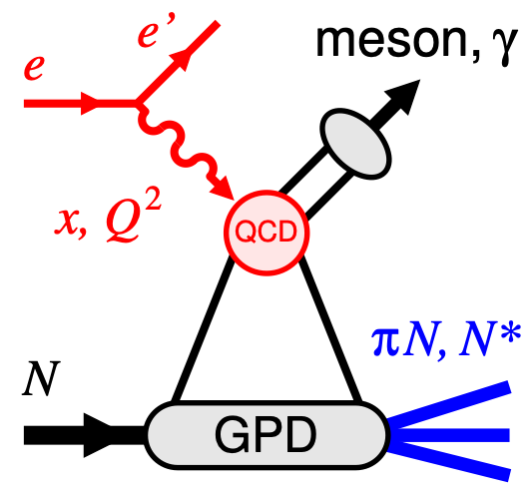
Exclusive scattering processes e + N → e’ + meson + N* sample the N → N* transition generalized parton distributions (GPDs), extending the concept of N → N GPDs. These are new probes of excited baryon structure in QCD. In these studies, we established spin structure of N → Δ transition GPDs and discovered new “tensor-polarized” parton distribution. We further formulated concept of QCD angular momentum in baryon transitions and predicted N → Δ transition angular momentum using 1/Nc expansion. This led community effort to formulate physics program in transition GPDs at JLab 12GeV and EIC (White Paper). This series of the study will stimulate emerging physics program in transition GPDs. In particular, first results from JLab12 Concept enables systematic studies of excited baryon structure in QCD, including its mechanical properties, 3D spatial structure. We also emphasize possible future measurements with EIC far-forward detectors.
Figure illustrates the exclusive processes with N → N* transition which can probe the transition GPDs.
Gravitational form factors from near threshold heavy quarkonium photo-production
Yuxun Guo, Xiangdong Ji, Feng Yuan, Proton’s gluon GPDs at large skewness and gravitational form factors from near threshold heavy quarkonium photo-production, Phys.Rev.D 109 (2024) 1, 014014
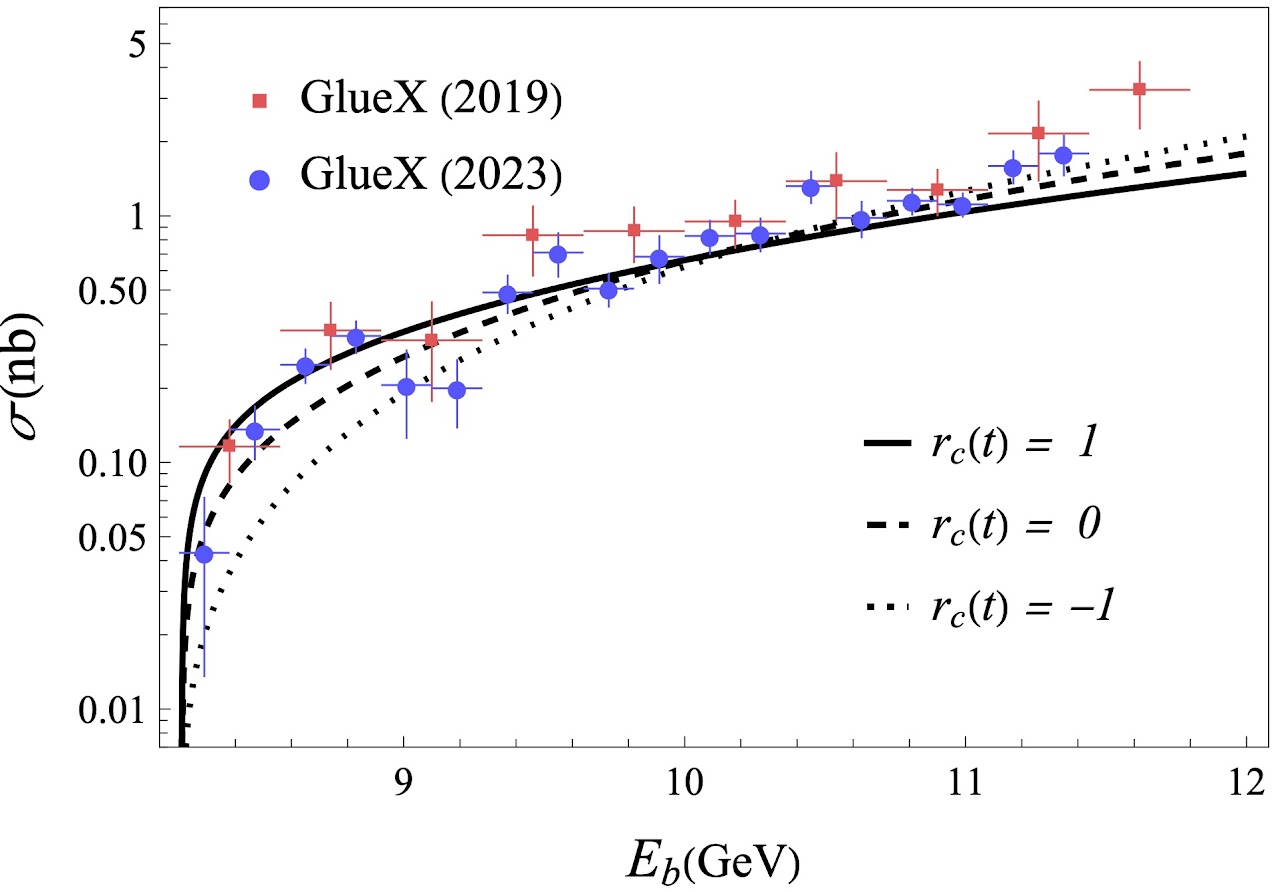
We study the exclusive near-threshold photo-production of heavy quarkonium in the framework of the GPD factorization, taking the J/ψ production as an example. Due to the threshold kinematics, the Compton-like amplitudes are related to gluon GPDs at large skewness ξ, distinct from the common kinematics in asymptotic high energy where the skewness is typically small. We discuss the nature of large-ξ expansion of these amplitudes in terms of the moments of gluon GPDs in the large-ξ limit. Based on that, we propose several ways to extract the first few moments of the gluon GPDs from these amplitudes, with the leading ones corresponding to the gluonic gravitational or energy-momentum tensor form factors (GFFs). We apply these methods to analyze the recent near-threshold J/ψ production measurements by the J/ψ 007 experiment and GlueX collaboration, and find that the ξ-scaling of the measured differential cross sections is consistent with the asymptotic behavior. However, the current data are not accurate enough yet for a complete determination of the gluonic GFFs, and therefore we consider some prospects for better extractions in the future.
The figure here demonstrates the sensitivity of the total cross sections σ (nb) on different weights of Cg-form factor contributions with rC= 1, rC= 0, and rC=−1, respectively.
Spin-Orbital Correlations in Nucleons in the Large-Nc Limit
June-Young Kim, Ho-Yeon Won, Hyun-Chul Kim, Christian Weiss, Spin-orbit correlations in the nucleon in the large-Nc limit, Phys.Rev.D 110 (2024) 5, 054026, Published: Sep 1, 2024
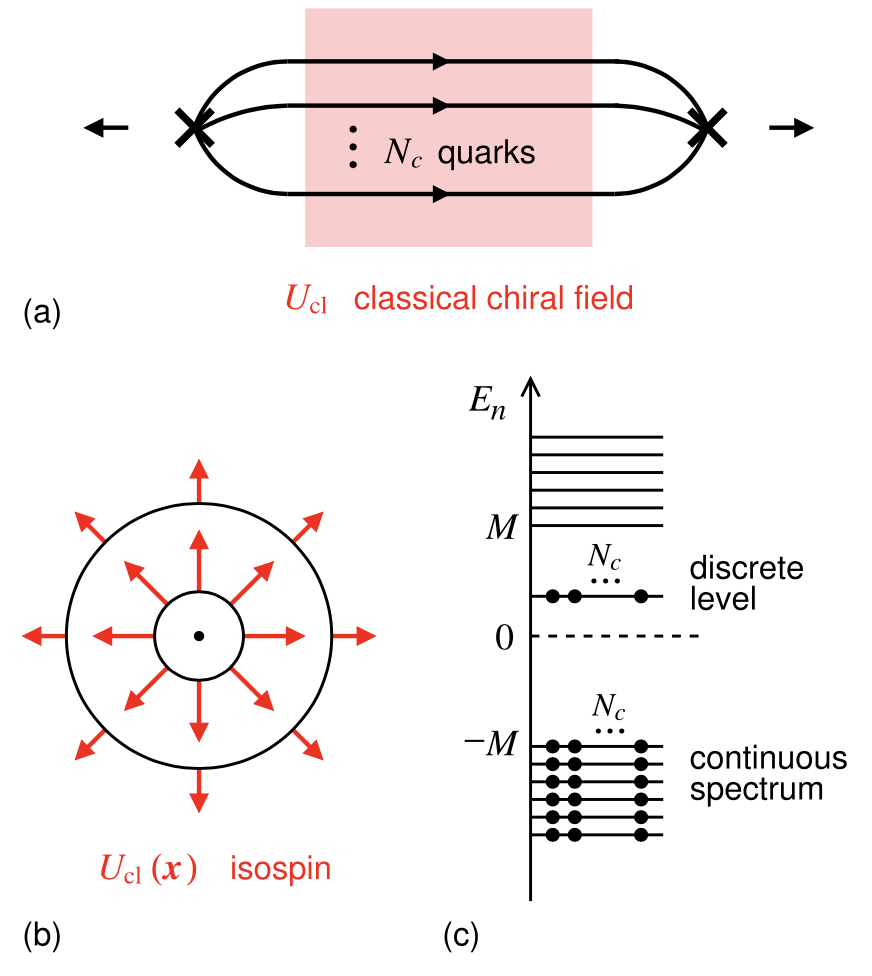
Spin-orbit correlations of quarks and gluons represents the next frontier after the study of the spin and orbital angular momentum distributions. The spin-orbit correlations are measured by the matrix elements of certain twist-3 QCD operators, which generalize the QCD energy-momentum tensor and can be connected with GPDs. In this paper, the spin-orbit correlations were analyzed in the large-Nc limit of QCD, where the dynamics becomes semiclassical and the nucleon can be described in a mean-field picture. It was shown that the effective spin-flavor interactions induced by chiral symmetry breaking have a major effect on the spin-orbit correlations of quarks and qualitatively change them compared to the quark model picture.
The figure here illustrates the emergence of baryons from the effective dynamics. (a) Correlation function of baryon currents in the large-Nc limit. (b) Spatial form of the classical chiral field (hedgehog). (c) Quark single-particle spectrum in the background of the classical chiral field.
Nonlinear extensions of the Schrödinger equation
Tom Dodge, Peter Schweitzer, Exactly solvable models of nonlinear extensions of the Schr¨odinger equation, Physica D 476 (2025) 134666, Published: Apr 9, 2025
A method is presented to construct exactly solvable nonlinear extensions of the Schr¨odinger equation. The method explores a correspondence which can be established under certain conditions between exactly solvable ordinary Schr¨odinger equations and exactly solvable nonlinear theories. We provide several examples illustrating the method. We rederive well-known soliton solutions and find new exactly solvable nonlinear theories in various space dimensions which, to the best of our knowledge, have not yet been discussed in literature. Our method can be used to construct further nonlinear theories and generalized to relativistic soliton theories, and may have many applications
Nucleon GPDs in nonlocal chiral effective theory
Zhengyang Gao, Fangcheng He, Chueng-Ryong Ji, W. Melnitchouk, Y. Salamu and P. Wang, Nonlocal chiral contributions to generalized parton distributions of the proton at nonzero skewness, Phys. Rev. D110, 054049 (2024). Published 30 September, 2024

The spin-averaged GPDs Hq and Eq for the u and d quarks in the nucleon, as well as their moments, were studied in the framework of nonlocal chiral effective field theory (EFT). Chiral EFT is a powerful tool for studying flavor asymmetries in quark distributions, particularly those associated with the pion cloud of the nucleon. Nonlocal EFT imposes local gauge invariance and generates a covariant correlation function, which renders loop integrals convergent, and extends the range of applicability of the theory to larger momentum transfers than in local EFT. The obtained three-dimensional GPDs can then be used to compute physical observables up to momentum transfers squared of t = 1 GeV2 and compared with experiment.
This study derived generalized convolution formulas for nonzero skewness GPDs, which involve both the DGLAP and ERBL regions, and verified that the moments of the GPDs satisfy the correct polynomial properties. The gauge invariant introduction of a covariant correlation function within the nonlocal chiral EFT, representing the finite extent of hadrons, extends the applicability of the theory up to momentum transfers ~ 1 GeV. An obvious extension of this work is the inclusion of contributions from the coupling to intermediate state baryons. The strategy employed would also facilitate calculation of chiral loop contributions to spin-dependent GPDs, and even generalized transverse momentum distributions, which can provide further insights into the three-dimensional structure of the proton.
The figure here shows the representation of the convolution formula and the three-dimensional distribution of u quarks as a function of x and t for fixed skewness ξ = 0.1.
See also: P. Wang, Fangcheng He, Chueng-Ryong Ji and W. Melnitchouk, Nucleon form factors and parton distributions in nonlocal chiral effective theory, Prog. Part. Nucl. Phys. 129, 104017 (2023).
The proton as seen with a finite speed of light
Adam Freese and Gerald A. Miller, Synchronization effects on rest frame energy and momentum densities in the proton, Phys.Rev.D 108 (2023) 9, 094026. Published 16 November, 2023
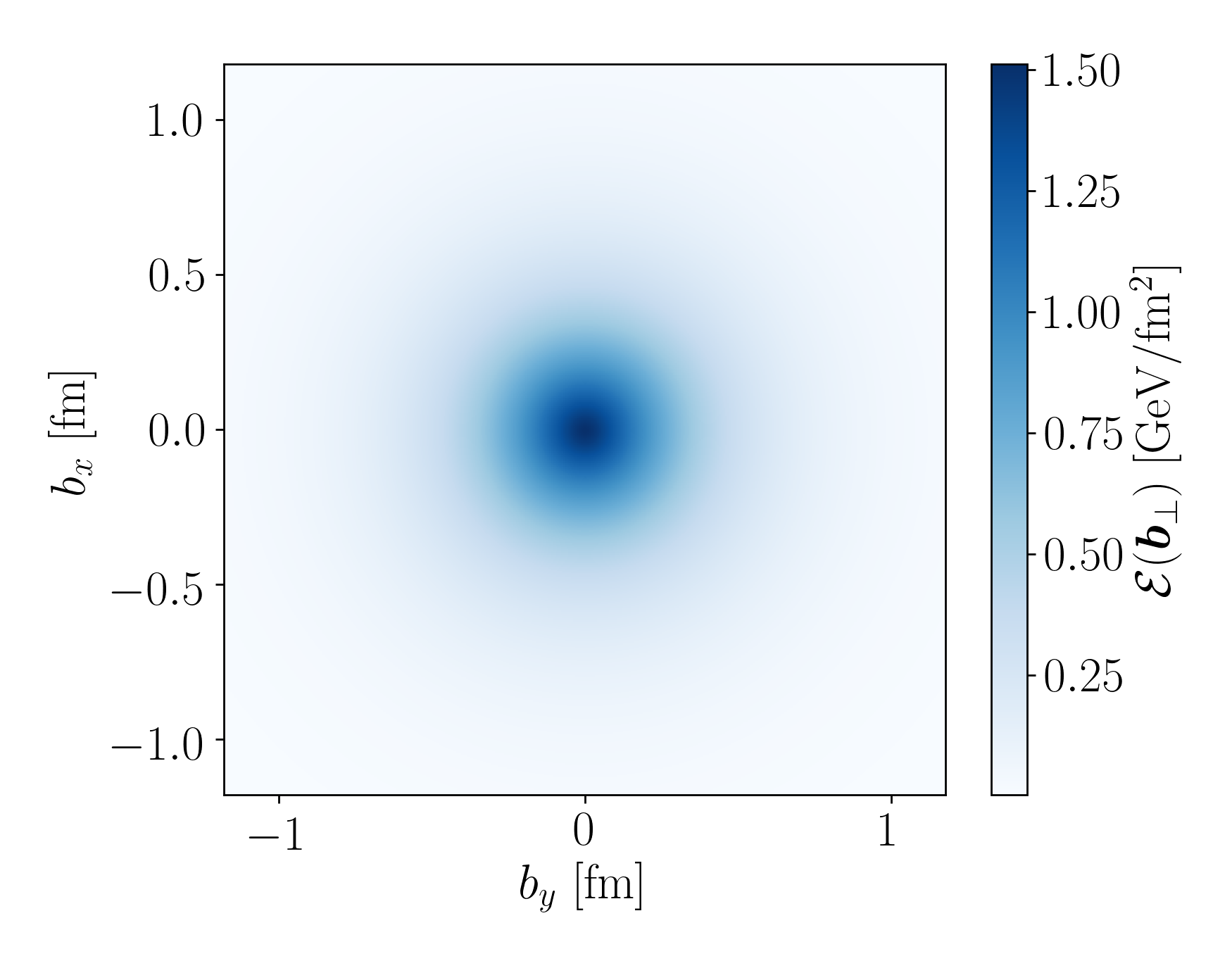
This work shows how relativistic effects can be fully accounted for in the image enhancement by using an alternate time synchronization convention. Essentially, one should consider everything they see in the direction of the proton as happening in the present. Normally—under what’s called the Einstein synchronization convention—distant events are considered to happen in the past, and a two-way signal needs to be bounced between two locations to determine the time delay and properly synchronize clocks at these locations. But these clocks are only synchronized in a single reference frame, and desynchronized in any other frame. On the other hand, if multiple clocks are set to a common time at the moment a single wave-front of light passes through them—a convention we call light front synchronization—then these clocks can still be seen as synchronized by an observer in any state of motion.
When using light front synchronization, a proton in any state of motion actually does have the same structure, allowing experimental images to be unblurred in a relativistically exact way. Moreover, these enhanced images contain optical effects arising from the finite speed of light, such as redshifts and blueshifts, and are in effect images of what the proton looks like to an observer seeing the proton using light fronts.
The figure shows the relativistic effects can be fully accounted for in producing spatial photographs of the proton by using an alternate time synchronization convention.
Theory Advance in Exclusive Photoproduction of Heavy Quarkonia
Sarah K. Blask, Sean Fleming, Thomas Mehen, Jyotirmoy Roy, Iain W. Stewart, Fanyi Zhao, Relativistic corrections to exclusive photoproduction of Quarkonia near-threshold, e-Print: 2506.18905 [hep-ph]
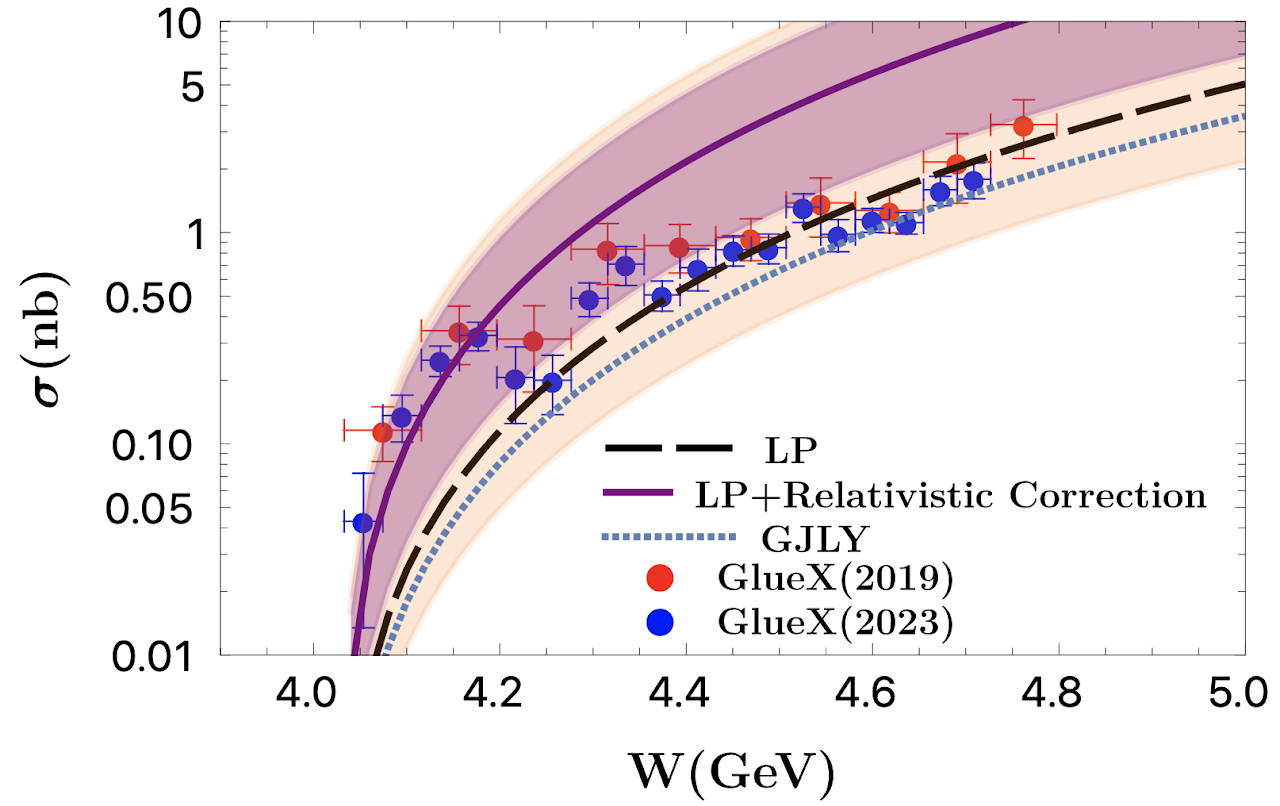
Non-relativistic QCD (NRQCD) is used to calculate the relativistic correction to the amplitude for exclusive photoproduction of vector Quarkonia in the near-threshold region within the generalized parton distribution (GPD) framework. The relativistic corrections are found to be large for J/ψ. Cross-sections for both J/ψ and Υ are calculated with the former being compared to the data. We also demonstrate the presence of endpoint divergences for the relativistic correction away from the near-threshold regime.
The figure here shows the relativistic corrections to exclusive photoproduction of Quarkonia near-threshold Log plot of the cross-section for J/ψ production, where the threshold region starts from the smallest values of W shown. The leading power (LP) and the relativistic correction to LP obtained from this work are shown in thick (purple) and dashed (black) lines respectively. The dotted line corresponds to LP result from. The yellow and purple shaded regions give two different estimates for the uncertainty from missing power corrections that are of the same size as those computed here.
This work is dedicate to the memory of Thomas Mehen (1970- 2024) and Fanyi Zhao (1996-2024).

